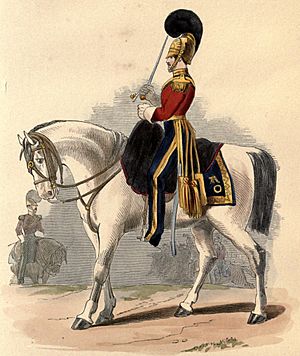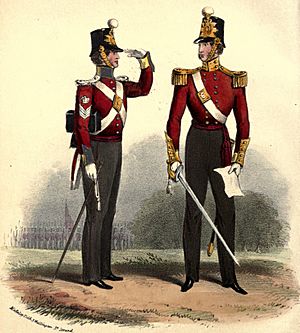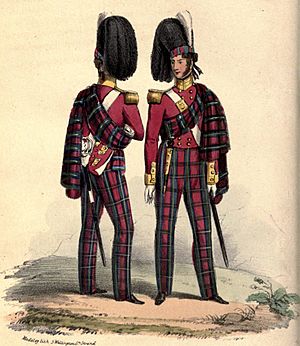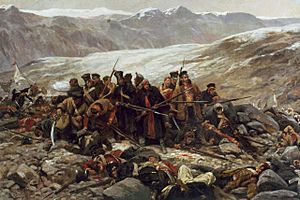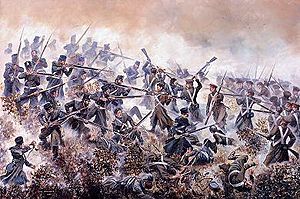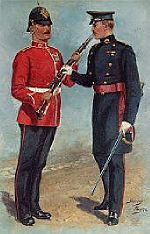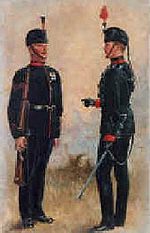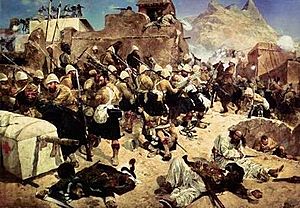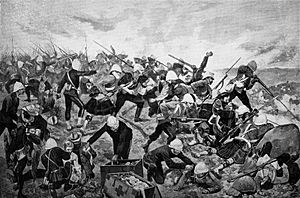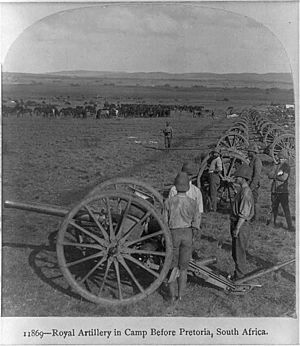British Army during the Victorian Era facts for kids
Quick facts for kids British Army (Victorian Era) |
|
|---|---|
| Active | 1837-1901 |
| Country | United Kingdom of Great Britain & Ireland |
| Size | 124,000 (Peak (1880-81)) |
| Nickname(s) | Redcoats |
| Colors | Red (Infantry), Dark Blue (Cavalry & Artillery) |
| Equipment |
|
The British Army during the Victorian era was the army of the United Kingdom when Queen Victoria was in charge, from 1837 to 1901. This was a time of huge changes in technology and society. The British Empire grew a lot, and new factories and machines changed how people lived and worked.
At the start of Victoria's reign, the army was quite similar to how it was during the Napoleonic Wars. But over time, it changed a lot. The Crimean War (1854) and the Indian Rebellion of 1857 showed that the army needed big improvements. From 1868 to 1881, many important changes were made.
By the time Queen Victoria died, the army was fighting in the Second Boer War. Its weapons, transport, and gear had changed a lot because of the Industrial Revolution. Soldiers also had better education. However, some old traditions from the Duke of Wellington's time remained. The army's main job was to protect the huge British Empire, which covered almost a quarter of the world.
Contents
Early Victorian Army (1837–1854)
In the early Victorian years, the British Army stayed much the same. The Duke of Wellington, a famous general, was in charge until 1852. He and the leaders after him didn't think big changes were needed for how the army was run or how soldiers dressed and fought.
Joining the Army
In those days, a young man might join the army after a recruiting sergeant offered him a drink in a pub. If he accepted the "Queen's shilling" (a coin), he had a few days to change his mind. Then, he had a medical check and took an oath to the Queen.
Soldiers usually joined for life, or for 21 years. Later, in 1847, they could join for 10 or 12 years. But after serving so long, most soldiers found it hard to get civilian jobs. So, they often joined up again. This meant regiments had many experienced soldiers but no trained reserves ready to help.
Soldiers were supposed to get one shilling a day. But much of this was taken away for food, clothes, and medical care. By 1847, a soldier had to receive at least one penny a day, no matter what.
Many soldiers got sick from serving in hot, unhealthy places. Barracks in Britain were often crowded and dirty, even worse than prisons. Drinking too much was also a big problem and caused most of the rule-breaking.
Punishments could be harsh. Serious crimes like mutiny could lead to the death penalty. For smaller problems, soldiers might get extra duties or lose pay. Flogging (being whipped) was also used for many offences. The number of lashes was reduced over time, from 2,000 in 1782 to 50 in 1847.
Only a few soldiers were allowed to marry. Wives and children lived in the barracks, often with little privacy. Wives often helped by doing laundry for the soldiers. When units went overseas, even fewer wives were allowed to go, forcing families to separate for years.
Officers' Roles
Becoming an officer in the infantry or cavalry usually meant buying your position. You also had to buy each promotion. This system meant that rich officers could rise quickly, even if they weren't the best trained. Poor officers, even if they were good, might stay in the same rank for decades.
This system also meant that officers from wealthy families often looked down on officers in the artillery and engineers. These officers had to study at the Royal Military Academy, Woolwich and earned their promotions based on how long they served.
Army Structure
Cavalry Units
The cavalry had different types of regiments:
- 3 Household Cavalry Regiments (like the Queen's guards)
- 7 Dragoon Guard Regiments
- 4 Dragoon Regiments
- 4 Light Dragoon Regiments
- 4 Hussar Regiments
- 4 Lancer Regiments
Heavy cavalry (like Dragoon Guards) were meant for powerful charges, while light cavalry (like Hussars) were for scouting. But in the British Army, they often used similar horses. Cavalry used swords that were mainly for cutting.
Lancer regiments, which used long spears called lances, were added after the Napoleonic Wars. They copied the style of Polish soldiers.
Most heavy cavalry wore red uniforms. Light cavalry wore blue jackets from the 1780s, but in 1830, all cavalry were ordered to wear red. This changed back in 1840, and most light cavalry went back to blue.
Infantry Units
By 1855, the infantry included:
- 3 Foot Guard Regiments
- 3 Fusilier Regiments
- 8 Light Infantry Regiments
- 7 Highland Infantry Regiments
- 79 Line Infantry Regiments
- 2 Rifle Regiments
Some regiments had more than one battalion (a large group of soldiers). Most battalions had a headquarters, six fighting companies, and four training companies.
Most infantry wore bright red jackets called coatees. They had greatcoats for cold weather and white cotton uniforms for hot climates like India. Highland regiments wore traditional Scottish kilts. Rifle regiments wore dark green uniforms, almost black.
Soldiers wore different hats over time. The tall "Belgic" shako from the Napoleonic Wars was replaced by a "bell-topped" shako, then the "Albert" shako. Guards wore tall bearskin hats. Highland regiments wore feather bonnets. A stiff leather collar called a "stock" was worn until 1855 to make soldiers keep their heads up.
Most infantry used the Brown Bess musket, a weapon that had been around for a long time. It was updated in 1842 to use a percussion cap instead of a flintlock. Rifle regiments used the Brunswick Rifle.
Artillery and Engineers
The artillery and engineers were managed by a different office, the Board of Ordnance, not the War Office. Officers in these groups had to pass courses at the Royal Military Academy, Woolwich. They didn't buy their ranks.
The Royal Artillery handled field guns and heavy cannons. The Royal Horse Artillery worked with cavalry and used cavalry ranks. Gunners wore blue uniforms.
The Royal Engineers were specialist officers. The Royal Sappers and Miners were soldiers who built things like forts and bridges. Both the Royal Artillery and Royal Engineers had the mottoes Ubique ("Everywhere") and Quo fas et gloria ducunt ("Where right and glory lead").
Colonial Forces
The British Empire had many colonies. Some colonies, like Canada, raised their own military forces. Other colonies had local reserve units. These units were often funded by the British War Office and were considered part of the British Army.
One regular regiment, the West India Regiment, was part of the British Army. However, its black soldiers were paid less and had different conditions than other British soldiers.
Army's Purpose and Fights
The main job of the British Army was to keep order in Britain, protect and expand the British Empire, and fight in wars in Europe. After Napoleon I was defeated in 1815, Europe was peaceful for almost 40 years.
Keeping Order at Home
In Britain, soldiers sometimes helped the government stop protests and riots. This was often caused by poverty or political movements like the Chartists. Cavalry units were especially used to stop problems in the countryside. This duty could make soldiers feel down and made the army less popular.
Over time, as more people in Britain got the right to vote and police forces were created, soldiers were called out less often to keep order.
British East India Company's Armies
The British East India Company was a trading company that became very powerful in India. It had its own armies, made up mostly of Indian soldiers called sepoys. By the start of Victoria's reign, these armies were very large, with over 150,000 soldiers.
The Company also had its own white "European" units. British Army units, called "Queen's" troops, also served in India, and the Company paid for them. The highest positions in the Company's armies were for British Army officers.
Indian soldiers could not rise to high ranks. British officers had to learn Indian languages. Promotion in the Company's army was based on how long you served, which meant good officers might not get promoted quickly.
The Company's army wore similar uniforms and used similar equipment to the British Army.
Expanding in India
The British kept expanding their control in India. They were also worried about Russia expanding into Central Asia and Afghanistan. This led to the First Anglo-Afghan War. The British captured Kabul, but then a British army was almost completely wiped out trying to retreat from Kabul (the Massacre of Elphinstone's Army). Even though the British later recaptured Kabul, they left Afghanistan having lost respect.
After defeating other Indian states, only the Sikh Empire remained fully independent. Wars with the Sikhs (the First Anglo-Sikh War and Second Anglo-Sikh War) were tough fights, but the British eventually won and took control of the Punjab region. This meant no Indian state was fully self-governing anymore.
The British also fought in Burma (the First Burmese War and Second Anglo-Burmese War) and against China in the First Opium War. In China, the British easily defeated the old Chinese armies, which led to Hong Kong becoming British.
Mid-Century Challenges (1854–1857)
In the mid-1800s, the British Army faced two big wars: the Crimean War and the Indian Rebellion of 1857. Even though they won, these wars showed that the army needed major changes. Many soldiers were not fit to fight, and there were no trained reserves.
The Crimean War
The Crimean War was the first major war in Europe since 1815. It made the public lose trust in the army.
Before the war, new weapons like the Minié rifle and later the Enfield Rifle were introduced. But the war showed how unprepared the army was. Newspapers like The Times had reporters who wrote about the army's problems, making the public very aware.
The army sent to the Crimea was badly led. The system where officers bought their ranks was heavily criticized, especially after the disastrous Charge of the Light Brigade at the Battle of Balaclava.
The system for getting supplies and transport was terrible. Food often arrived late and rotted. Many soldiers died from disease and cold during the winter of 1854–1855.
After the war, the Victoria Cross, the highest award for bravery, was created.
The Indian Rebellion of 1857
Soon after the Crimean War, the Indian Rebellion of 1857 (also called the Indian Mutiny) broke out.
Most of the East India Company's 280,000 soldiers were Indian. Many Indians were worried about British changes to their society and religious traditions. A new rifle cartridge, believed to be greased with animal fat, caused a major problem for Hindu and Muslim soldiers.
In May 1857, soldiers in Meerut rebelled and marched to Delhi. Soon, much of northern and central India was out of British control. There were only 35,000 British soldiers in India, spread out. But the rebellion mostly stayed in one area, and the rebels lacked strong leaders. British troops, along with Gurkha and Sikh soldiers, brutally put down the rebellion.
After the rebellion, control of India moved from the East India Company to the British Crown. The Company's white "European" units became part of the British Army. A new British Indian Army was formed, mostly from groups less involved in the rebellion. Only British officers served in this new Indian Army.
Volunteer Soldiers
In the 1850s, there was a fear of war with France. This led to many wealthy people forming volunteer units called Volunteer Rifle Corps. These units were made up of citizens who wanted to help defend Britain. They often wore dark green or grey uniforms, different from the regular army's red.
Cardwell and Childers Reforms (1868–1881)
By 1861, the British Army had about 220,000 soldiers. In 1868, a new government led by William Ewart Gladstone came to power. Edward Cardwell was the new Secretary of State for War. He brought in big changes to modernize the army.
Cardwell's Changes
Cardwell's reforms aimed to put the War Office in charge, stop officers from buying their ranks, create reserve forces, and have shorter service times for soldiers.
Ending Officer Purchase
The most debated change was ending the system of officers buying their ranks. This system meant that rich families had invested a lot of money. The government decided to pay officers back for their commissions and then completely stopped the purchase system.
Now, officers were promoted based on how long they served and how good they were. This was supposed to allow good officers to rise, no matter how rich they were. However, officers still needed a lot of money to live the expected lifestyle, so most still came from wealthy families.
New Service Terms
Cardwell introduced the Army Enlistment Act (1870). This reduced the normal service time from 21 years to 12 years. For infantry, soldiers served six years actively and then six years in the Army Reserve. This meant the army now had trained reserves it could call upon in emergencies.
In 1881, infantry service was changed to seven years active duty and five years in the reserve.
Cardwell also reorganized regiments in 1872. Each cavalry and infantry regiment got a fixed home base and recruiting area. Single-battalion infantry regiments were paired up, with one battalion serving overseas and the other in Britain. They would switch roles after a few years. This was easier because steamships and the Suez Canal made moving troops much faster.
Other Changes
The Board of Ordnance and Commissariat (supply department) were brought under the War Office. This made the army's administration much simpler.
Harsh punishments like branding soldiers for desertion were stopped. Flogging was ended for troops serving in Britain, and later for all soldiers in 1881. It was replaced by "Field Punishment Number One."
Childers' Changes
After a break, new reforms, called the Childers reforms, came into effect in 1881. These continued Cardwell's work. They strengthened regiments' ties to counties by giving them county names instead of just numbers. Most single-battalion regiments were combined into two-battalion regiments.
The Childers Reforms also brought the militia and volunteers closer to the regular army. Most infantry regiments now had a third militia battalion and a fourth volunteer battalion. This helped train and organize these reserve forces better.
Cavalry regiments were less affected by these changes. They remained small.
Late Victorian Army (1868–1901)
Soldier Life and Training
After the Cardwell Reforms, most soldiers served a few years with the regular army before joining the reserves. Only those who became warrant officers or senior non-commissioned officers usually served the full 21 years.
Soldiers' pay was increased, and they no longer had to pay for basic food rations or hospital care. They could also earn extra pay for good conduct.
The army started requiring soldiers to have a basic education to be promoted. From 1871, new recruits had compulsory education classes. By the 1890s, almost all soldiers could read and write.
More soldiers were allowed to marry, and wives could travel with their husbands when units moved.
New barracks were built that were healthier and more spacious. These improvements, along with medical advances, greatly reduced deaths from disease among soldiers.
Army Leaders
After the purchase system ended, most officers went to the Royal Military Academy, Sandhurst. They had to pass exams to get in and meet training standards. However, officers still needed a lot of personal money to maintain their lifestyle, so most still came from wealthy families.
For almost 50 years, the Queen's cousin, the Duke of Cambridge, was the Commander-in-Chief. He was quite traditional and didn't like many changes.
Much of the army's planning and operations were led by General Garnet Wolseley. He was known for being a great organizer. Wolseley helped appoint a group of officers, known as the "Wolseley ring," to important positions. There was a rivalry between Wolseley's group and the "Roberts ring," who were followers of General Frederick Roberts and had served mostly in India. This rivalry sometimes made it hard to choose senior officers.
The army had a Staff College, Camberley for training officers, but it wasn't as good as the Prussian military academy. Officers often preferred serving in regiments rather than going to staff college.
Army Plans
One goal of the reforms was to create an expeditionary force that could be sent to wars without leaving Britain or the empire unprotected. In 1882, a force was sent to Egypt to protect the Suez Canal.
By the late 1880s, the plan was to have an Expeditionary Force of two army corps ready to go overseas. This was finally achieved in the early 1900s.
Uniforms and Weapons
Infantry Gear
The infantry's tight red coatee was replaced by a looser tunic in 1855, and later by a double-breasted tunic. Equipment was moved from crossbelts to waistbelts and "valises" to distribute weight better.
For headgear, the shako was used, becoming shorter over time. In 1877, a conical Foreign Service helmet was adopted for overseas use, made of cork to protect from the sun. The Home Service helmet was adopted for Britain in 1878. Highland regiments kept their feather bonnets.
For campaigns, soldiers often wore heavy red uniforms in hot climates. However, in India, troops started wearing drab or khakee (dust-colored) cloth uniforms from the 1840s. Khaki became standard overseas dress by 1897. The white Foreign Service helmet was often stained to be less noticeable.
The Snider–Enfield rifle was introduced in 1866, followed by the Martini–Henry in 1871, and then the magazine-loading Lee–Metford and Lee–Enfield rifles in the 1890s. From the 1880s, the infantry also started using rapid-firing machine guns like the Maxim gun, which was very effective against large enemy attacks.
Officers bought their own uniforms and weapons. They carried swords and, from 1856, the Beaumont–Adams revolver. Later, Webley revolvers became standard. The Sam Browne belt, a practical belt system for officers, was introduced and later adopted by armies worldwide.
Cavalry Gear
In 1853, a new sword was introduced for all cavalry, designed for both cutting and thrusting. Later, in 1882, stiffer swords meant more for thrusting were adopted.
Cavalry used carbine (shorter) versions of the infantry's rifles. They also experimented with different carbines.
Artillery Gear
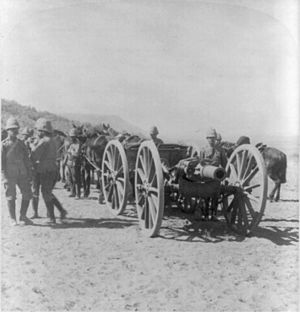
The School of Gunnery was set up in 1859. In 1862, the Royal Artillery grew by taking in the artillery units from the former British East India Company.
In 1899, the Royal Artillery was split into three groups: the Royal Horse Artillery, the Royal Field Artillery, and the Royal Garrison Artillery (for coastal defense and heavy guns).
The artillery tried breech-loading guns in 1859, but they had problems. So, they went back to muzzle-loading (but rifled) guns from 1871, which were slower to fire. Breech-loading guns were brought back in 1883.
The army also developed Mountain artillery, which used light guns that could be taken apart and carried by mules over rough land.
Engineers' Role
The Royal Engineers were greatly affected by new technology. Besides building forts, roads, and bridges, they also managed field telegraphs, built and ran railways, and even used balloons for observing enemy positions.
Major Campaigns
India, Afghanistan, China, and Burma
After the Indian Rebellion, the main opposition in India came from the Pakhtun people on the North West Frontier. Many expeditions were sent to control rebellious tribes.
Britain was still worried about Russia in Central Asia. When Russia sent a diplomatic mission to Kabul, the British invaded Afghanistan again, starting the Second Anglo-Afghan War. After some initial wins, the British faced more rebellions. Lord Roberts' army in Kabul fought off Afghan attacks and then made a famous march to relieve another besieged garrison in Kandahar.
Later, there were more uprisings on the frontier as Britain expanded its control.
Further problems with China led to the Second Opium War. British, French, and American forces defeated China again. In 1900, British and Indian troops fought in the Boxer Rebellion. In Burma, the Third Anglo-Burmese War in 1886 led to the entire country being taken over by Britain.
Africa
There were several campaigns in Africa, a period called the Scramble for Africa. These included expeditions to Abyssinia in 1868 and Ashanti in 1874.
South Africa
Britain had taken the Cape of Good Hope from Holland. They fought against African peoples like the Xhosa. Dutch-speaking settlers, called Boers, moved north to set up their own republics.
In 1879, the Anglo-Zulu War began. The British suffered a big defeat at Isandlwana, but then famously defended Rorke's Drift. The Zulus were eventually defeated.
Soon after, the Boers in the Transvaal republic gained independence after the First Anglo-Boer War. The British were heavily defeated at the Battle of Majuba. Many British soldiers wanted revenge for this loss.
Egypt and Sudan
The Suez Canal, opened in 1869, was very important for Britain's route to India. In 1882, Britain intervened in Egypt during the Urabi Revolt. General Wolseley used new tactics to defeat the Egyptian forces at the Battle of Tel el-Kebir. Britain then took control of much of Egypt.
This also led Britain to get involved in Sudan. General Charles George Gordon was sent to oversee a withdrawal but decided to defend Khartoum against the Mahdi. After a long siege, Gordon was killed. A British relief expedition arrived too late.
Years later, the British, led by General Kitchener, rebuilt an Egyptian army and advanced into Sudan. The Mahdi's successor was defeated at the Battle of Omdurman, and Britain took control of Sudan.
The Second Boer War
The Second Anglo-Boer War, which started near the end of Victoria's reign, was a huge event for the British Army. Britain sent many troops, including reserves and volunteers, to South Africa. However, the war showed many problems in the army's organization, training, and tactics.
The war began in 1899. The Boers quickly surrounded British forces. The British expected to win easily, but they suffered several defeats. It was clear that British tactics had not kept up with modern weapons. Soldiers were not good at shooting or fieldcraft.
Cavalry units were not very mobile. They used heavy horses and too much gear. Many horses died quickly. Instead, mounted infantry (infantry soldiers who rode horses) and colonial units (from Australia, New Zealand, and Canada) did much of the scouting and fast movements.
Supply arrangements often broke down. Lord Kitchener tried to fix this, but it caused more confusion at first.
Lord Roberts took command in South Africa. His forces overwhelmed the Boer armies and captured their capitals. However, many soldiers died from disease and lack of supplies.
The Boers then fought a guerrilla war for over a year. The British responded by moving Boer civilians, including women and children, into concentration camps, where many died from poor food and sanitation. Kitchener's methods eventually wore down the Boers.
This war also saw the first large deployment of troops from British Dominions like Australia, Canada, and New Zealand.
End of an Era
Queen Victoria died in 1901, just before the Boer War ended. By then, the British Army was very different from other European armies. British soldiers often used words from Hindi, Urdu, and Arabic, showing how much time they spent in India and Africa.
Most British officers and long-serving soldiers had real combat experience. However, they hadn't trained for large-scale wars like the big armies in Europe.
Many British politicians realized that Britain might soon have to fight in Europe. The Boer War also showed that many British recruits were not healthy enough to be soldiers.
The army learned many lessons from the Boer War. They improved infantry tactics and marksmanship. Cavalry also started to focus more on fighting on foot. These lessons helped prepare the army for the First World War a few years later.


